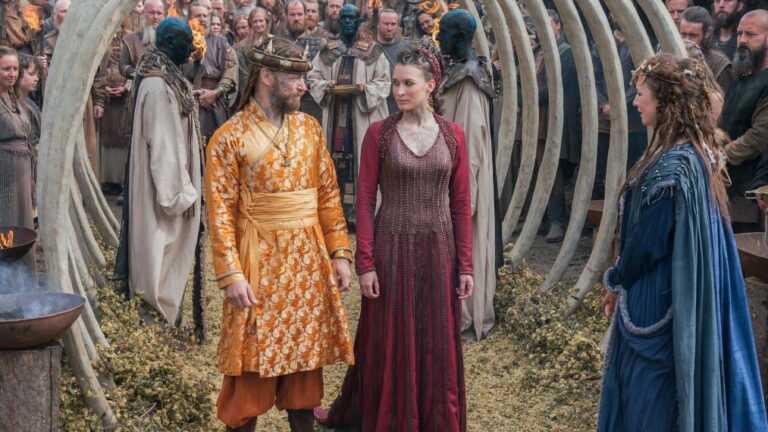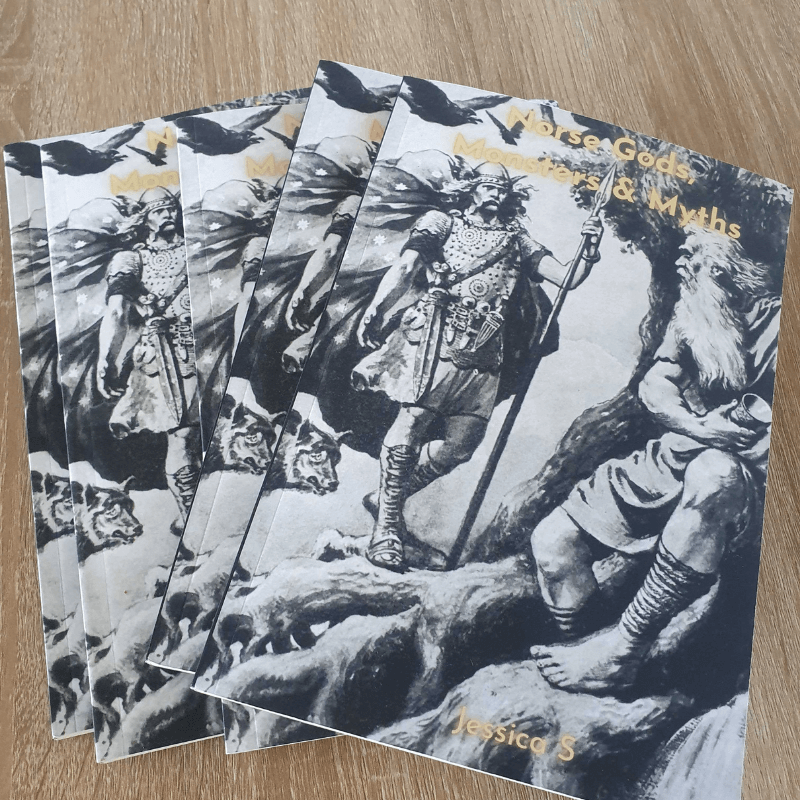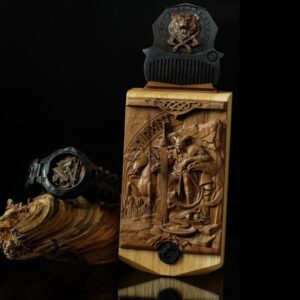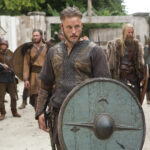Marriage an alliance between a man and a woman to build a family was essential to Viking life.
(Yes, homosexual relationships are mentioned in the surviving sources, but they weren’t considered formal, legal relationships equivalent to marriage.)
During the height of the Viking age, most free men were small landowners and needed a wife to oversee their household of extended family, workers, and slaves.
For the elites, like in other parts of the world, marriage was a way to make political alliances and secure power and property.
Of course, there was also the need for legitimate heirs.
Weddings were communal celebrations that also legitimized the resulting new social contract.
This article will explore what we know of the rituals and traditions surrounding Viking courtship, weddings, and marriages.
It is important to note that the Vikings were not a homogeneous group and that traditions differed across the regions occupied by the Vikings and the centuries of the Viking age.
There would also have been considerable differences between weddings held for the humble and elite in the same community.
With that caveat in place, we can generalize about Viking weddings and explore folk practices that still feature in modern Norse marriages.
Festarmal (Betrothal): Forming Marriage Alliances
Festarmal was a betrothal in Old Norse.
It meant an agreement had been struck between two families and a wedding was imminent.
Like in many ancient cultures, marriages weren’t usually love matches, but rather an alliance of resources.
Bride prices could provide financial resources.
Marriages could forge political alliances or be a peace offering to end an ongoing feud between families.
These connections were often sufficiently important that a widow would marry another member of the same family, often a brother, to maintain the connection.
Finding a Match
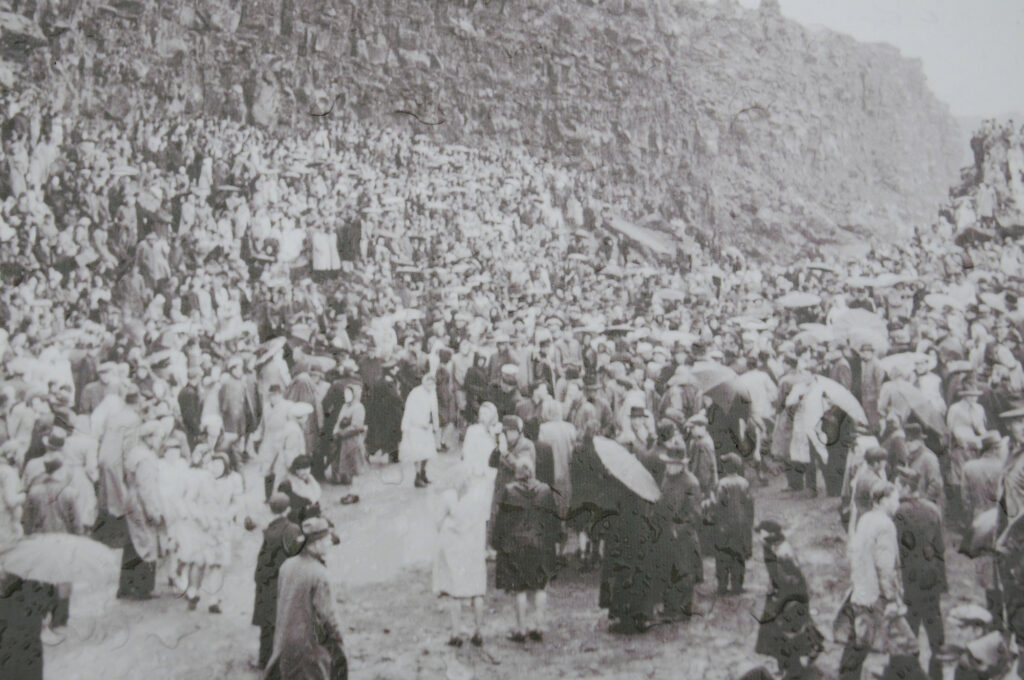
Of course, young men and women living in close proximity would sometimes fall for each other.
This could result in marriages that strengthened the local community.
However, if they did begin courting, the families would often want to seal an agreement quickly to avoid any illegitimate children.
If a father acknowledged an illegitimate child, it only received two-thirds of its support from its father’s family.
If he did not claim the child at all, it fell to the family of the mother to cover the full expense, plus it would limit her future marriage prospects.
Families also sought out viable marriage prospects at community gatherings such as Thing political meetings or festivals.
A man would bring his daughter to the gathering to do housekeeping and cooking tasks, and she would be available to present to prospective families.
She was generally considered marriageable from around the ages of 12-14, which suggests not long after she started menstruating.
When a suitable match was identified, the contract was brokered like any other contract.
Bride Price
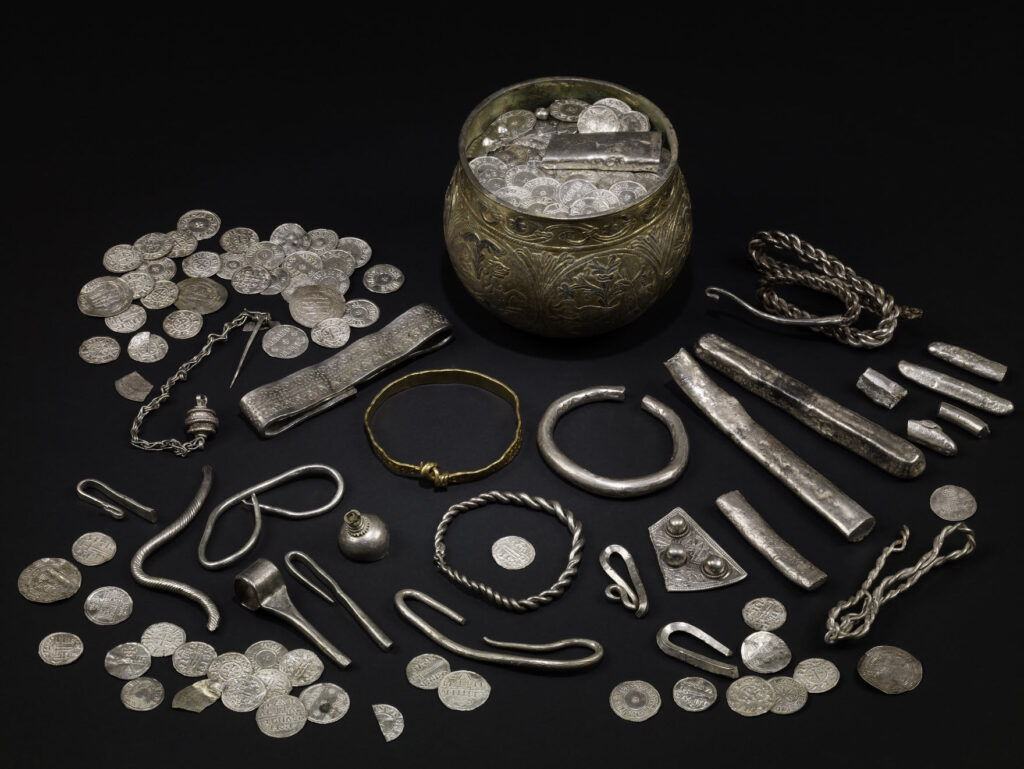
Contract negotiations included agreeing on a bride price, which consisted of three separate payments.
The mundr was a contribution by the groom to the bride’s family to cover the loss of her services.
It was the legally binding payment that moved the girl from the guardianship of her family to her husband.
While noble bride prices could be extremely rich, the minimum price was set at eight ounces of silver in Iceland and twelve ounces in Norway.
If a man could not pay the minimum, he was considered too poor to marry and support a wife.
The heiman fylgia was given to the bride by her family to support her upkeep and it was often equal to the mundr.
The morgengifu was paid to the bride by the groom following the consummation of the marriage.
This tradition was probably related to the wergild tradition that allowed someone to pay a price to compensate for the death of another person.
Consummating the marriage meant that pregnancy was possible, and this was one of the most dangerous prospects for women.
While all these prices were agreed upon as part of the contract, they were paid during the wedding ceremony.
Once the financial negotiations were completed, the arrangement was sealed with the handsal, probably witnessed would number at least six men since the oral agreement reached would have validity only as long as the witnesses were alive.
Love and Consent
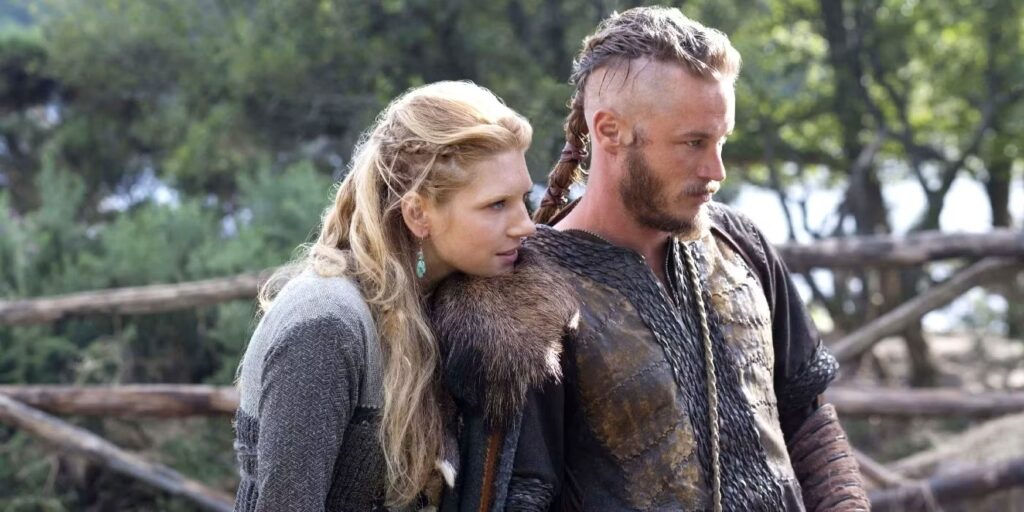
Consent does not seem to have been required from the bride or groom for their head of household to arrange their marriage.
While this could change for men as they came of age and gained independence, women were always under the power of a male relative, which could be her father, brother, or even son if he was of age.
In rare cases, widows of independent wealth might be able to direct their own futures, but this was the exception rather than the rule.
The evidence surrounding divorce varies with some sources suggesting that it was highly restricted to specific circumstances, while others indicate that either party could initiate divorce through a fairly simple process that required just a statement in front of witnesses.
Whatever the formal process, for most women divorce was only practical if they had a male family member willing to accept them into their household and support them.
While the permission of the bride and groom was not required, the sagas warned against forcing particularly unsavory or unwanted matches.
They often describe marriages in which a girl was forced to marry against her will ending in disaster.
Not just divorce, but also incidents such as maiming and death.
However, just because Viking betrothals did not require love does not mean that the Vikings did not believe in love.
Called inn mátki munr, or the mighty passion, it is a recurring theme in the Norse sagas and poetry.
There are stories of star-crossed lovers, such as the hero Sigurd and the Valkyrie Brynhildr, and stories of love that developed within marriage after the alliance was made.
It is telling that the giantess Gerdr had to be threatened with a fairly horrible fate to agree to marry the god Freyr, yet they were considered the epitome or sacred marriage and true love, which developed after the wedding.
The Vikings also believed in the magical power of the spoken word.
Consequently, in some places, it was illegal for skalds to recite mansongr, “maiden-songs” or love poems, as they were believed to have the power of a spell.
Brúdlaup (Wedding): Getting Married
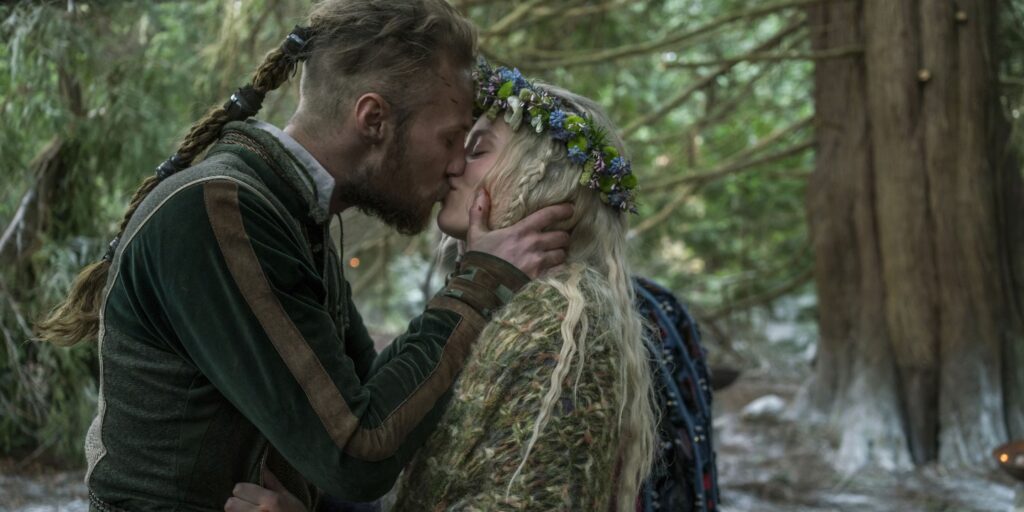
Sagas and other texts produced by the Vikings do not include details of wedding ceremonies, presumably because their audiences were familiar with them and would not find detailed descriptions interesting.
Therefore, Viking wedding customs have been reconstructed by scholars from occasional oblique references in the surviving texts and by folklorists and ethnographers who have reconstructed ancient practices by studying modern people.
Setting a Date
Once the contract was agreed, the families could set a date for the wedding.
It was usually hosted by the groom’s family as the bride would be joining his household.
Weddings usually happened on Fridays, as this was the day sacred to Frigg, the wife of Odin and the goddess of wives and wifely duties.
A big elite wedding would then have included several days of feasting, but even more modest weddings could run for several days if family and friends traveled to attend.
The date of ceremonies was limited by the seasons that allowed guests to travel. It could take some time to organize a wedding, some sources suggest up to a year, as resources had to be procured to feed the guests.
Time was also needed to brew the bridal mead, which the bride and groom shared from a single cup as part of the ceremony and was then served to all the guests.
Pre-Wedding Preparations
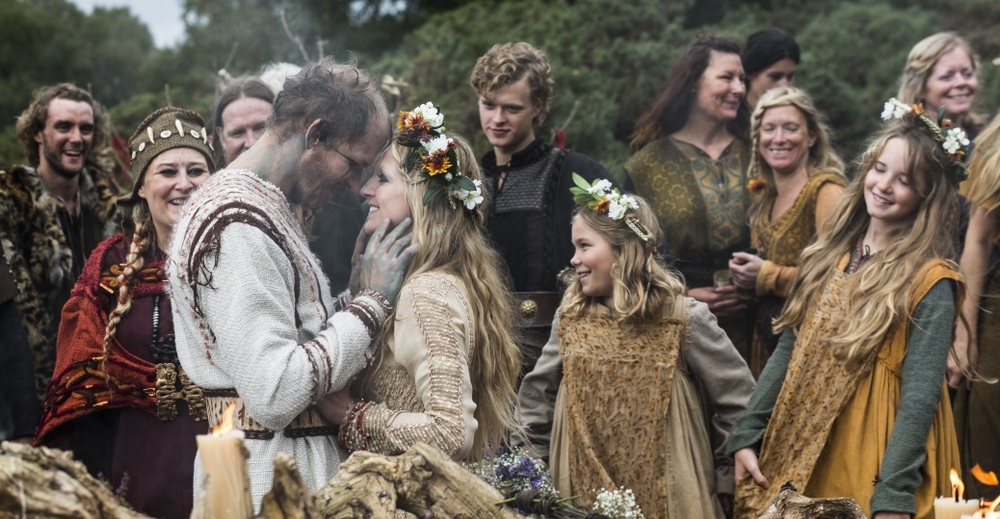
Before entering their new roles as man and wife, the bride and groom had to shed their previous identities and purify themselves to take on their new roles.
Women were probably sequestered with other married women from the community who stripped the bride of symbols of her unmarried status.
This may have included something like a kransen, a gilt circlet used by noble girls in Medieval Scandinavia.
The girl was then bathed, probably at hot springs and in saunas, which continue to be popular in modern Scandinavia.
Throughout these rituals, the older women would have shared knowledge the bride would need to know to make her marriage a success.
When it was time to dress, there is no indication that special attire was required, though the bride would surely have worn her best clothes.
She would have worn her hair styled loosely, for the last time before taking on the braids of a married woman.
There is evidence that she may also have worn a head covering as when Thor imitated Freyja and a mock-marriage to the giant Thrym, he is described as covering his head with bridal linen.
She probably also wore a bridal crown of some sort. For the wealthy, this could have been a gold or silver crown belonging to the family.
For more modest weddings, the crown was probably made from straw or corn.
The groom was also probably sequestered with married men from his family and community.
Rather than strip his old identity, he would claim a new one.
One tradition suggests that he would have to obtain an ancestral sword, which might involve breaking into a family tomb.
He may sometimes have been confronted by a family member representing the ancestors who would impart important wisdom.
He might also obtain the sword from a living family member.
The groom would then bathe and be dressed for the wedding, in no special costume but in his best attire and carrying his newly acquired sword.
The Ceremony
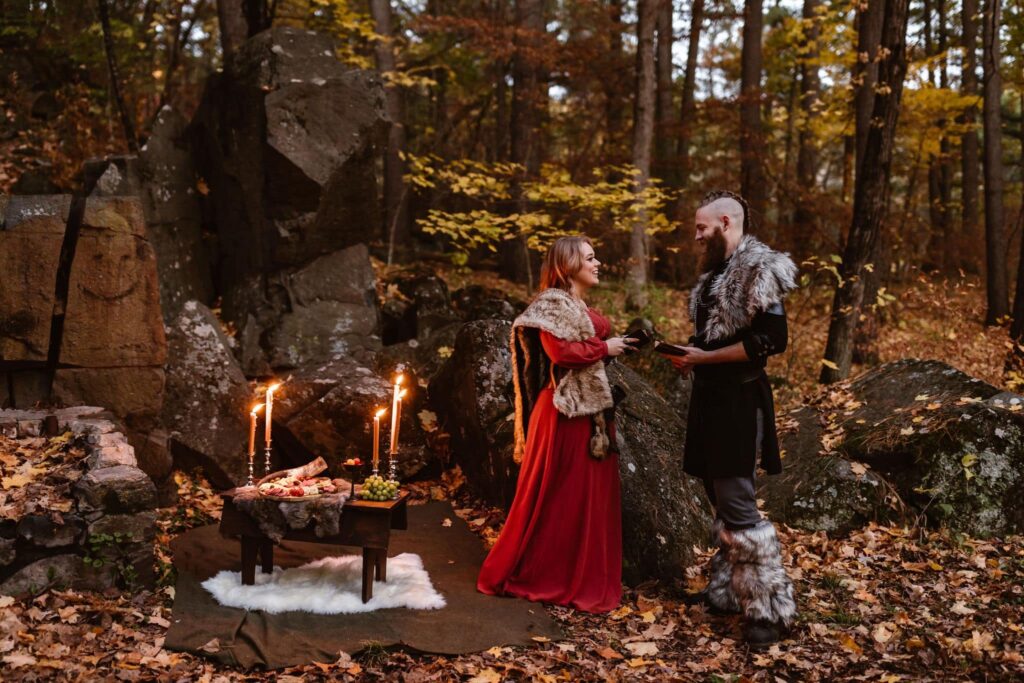
The ceremony itself would not start until the bride price and dowry were officially exchanged, in front of witnesses.
Only when business was done could the religious ceremony begin.
Ceremonies were probably held outdoors in groves or other places considered sacred.
A selected elder within the community would fulfill the role of officiant.
The Vikings did not have “professional priests,” and community leaders took on the role as necessary.
They would begin by summoning the attention of the gods to bless the union with a sacrifice.
It was traditional to sacrifice a goat to Thor, a sow to Freyja, or a boar or horse to Freyr.
Whichever animal was sacrificed, and later eaten at the feast, the blood was drained into a bowl.
A bunch of fir twigs was then dipped in the blood and used to splatter the couple, conferring the blessing of the gods.
At this point, the bride and groom may have exchanged keepsakes.
There are stories from the later Scandinavian period of the bride and groom exchanging rings.
In some cases, the groom may have given his sword to the bride, for her to hold on to for their future son.
The Party
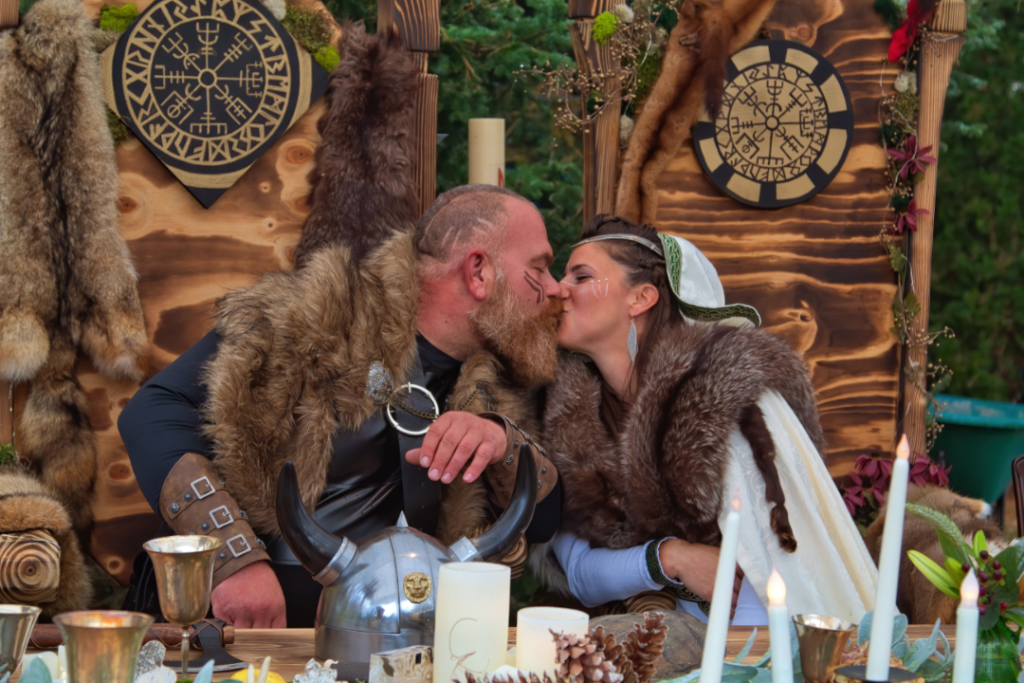
After the ceremony, there was, of course, the party.
Feasting was an important practice for community cohesion, so it was a necessary part of the ritual.
In some cases, the bride and groom had to race back to the location of the wedding, and whoever arrived last had to serve the other party beer for the rest of the night.
This is probably just one example of games played to entertain the wedding guests.
At some point during the feast, Thor’s hammer would be called upon to bless the union and the new social arrangement.
In some circumstances, a simulacrum of Mjolnir may have been brought forth for the purpose, while on others the calling of the hammer would have been purely metaphorical.
But what seems to have been common at all wedding feasts was a significant amount of drinking !
The most important part of the feast was the ceremonial drinking of the bridal mead, another of the legal requirements set forth by Grágás for the marriage to be considered valid.
The family had to provide enough bridal brew to keep everyone at the party in good spirits for a few days.
Married Life
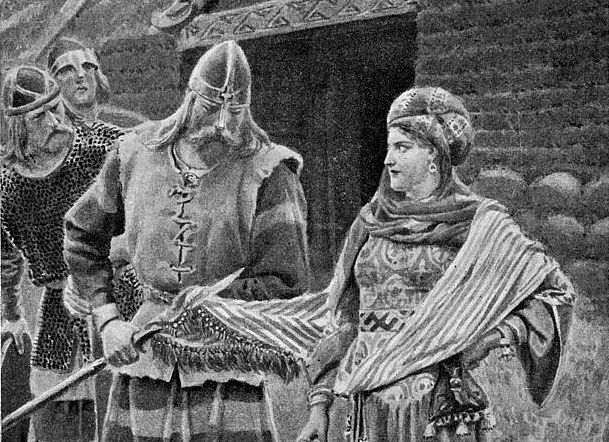
It was quite common in ancient European cultures that the consummation of a marriage had to be witnessed.
Exactly what this entailed is unclear, for example, whether the witnesses were required to be in the room, or just nearby to be aware of what was going on.
In later Scandinavian culture, it was common for six witnesses to be required to confirm the marriage.
Some sources suggest that the bed or bedclothes of the bride were adorned with gullgubber, which are tiny gold votive offerings.
One of the most common images on these pieces was a couple dancing, often interpreted as Freyr and Gerdr, suggesting an association with marriage.
The dreams of the bride were recorded during the night and were considered prophetic.
This could be linked back to the story of Aslaug having a prophetic dream that if she and Ragnar Lodbrok did not wait three days to consummate their marriage, their first child would be born boneless.
They did not wait, and the result was Ivar the Boneless.
The woman would receive the final payment of the contract in the morning, as well as other symbols of her new status, such as keys to the home.
Role of the Wife
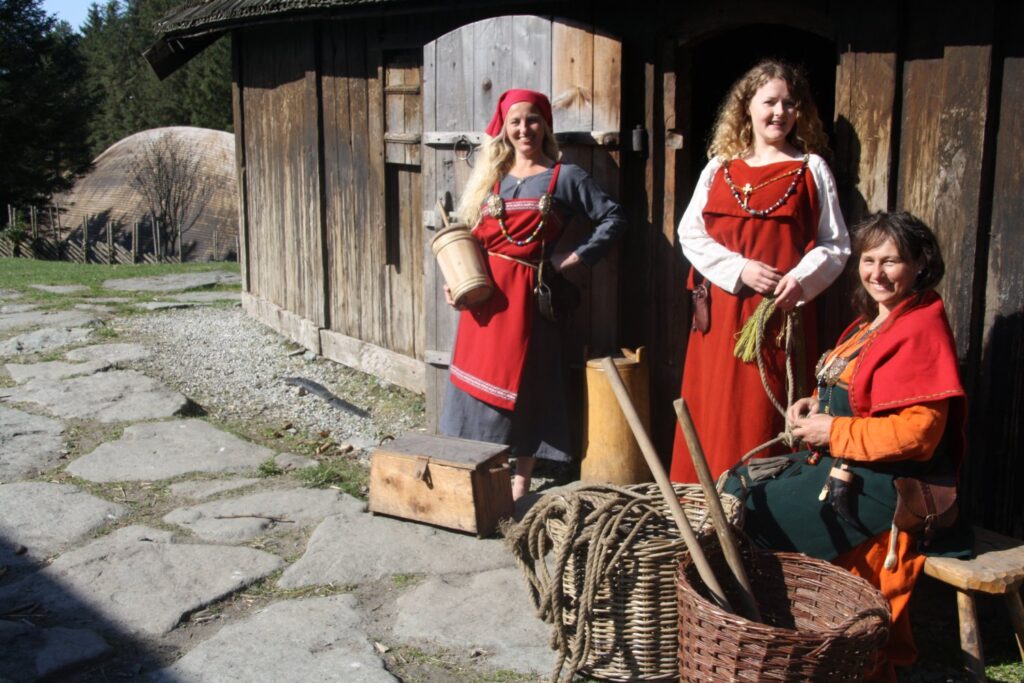
In her new role as wife, a woman had to submit to her husband legally, as he was the head of their household and represented everyone within the household in public functions.
But while men were out attending political Thing gatherings and raiding, his wife was responsible for the household, which was often an extended group including older relatives, children, foster children, slaves, and others.
The wife was responsible for overseeing the harvest, cooking, cleaning, making of clothes, and the education of children.
There is also strong evidence that she was responsible for the family finances and for household religious ceremonies.
It seems that women were expected to be faithful to their husbands, while the reverse was not true.
This is a common double standard in many societies, as men needed to know that their legitimate heirs were indeed theirs.
A man’s rights are reflected in laws like one allowing a husband to kill both an adulterous wife and her lover with no penalty.
The German commentator Adam of Bremen suggests that some Viking men took multiple wives.
However, the reality was that he took one legitimate wife, and his other partners were concubines, chosen from the lowest social classes, who lived in the home but were inferior to the legitimate wife.
Love and Marriage
While tantalizing evidence survives, it is hard to really understand what love and marriage were like in the Viking world.
Imagine trying to understand modern marriage just from our laws, photos of celebrity weddings, and stories in romantic novels.
It would be very far from what most of us experience day-to-day.
